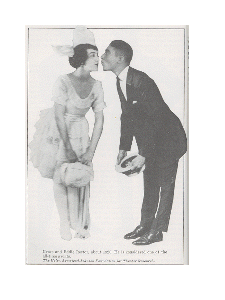 |
| Vaudeville was not the only stage on which tap dance was gaining momentum. Broadway revues turned tap dance into a glamourous representation of American theater and made it an American institution. Some of the more famous revues included Ned Wayburn's Minstrel Misses of 1906, which was part of the introduction of synchronized tap; the Florenz Ziegfeld Follies, featuring the first show dancers in a precision chorus line; and Lew Leslie's The Blackbirds of 1928, which starred Bill Robinson, his Broadway debut. A second media which pushed tap dance as a distinctly American artform was the musical comedy, a field pioneered by George M. Cohan of the family Vaudeville act, the Four Cohans. Cohan, widely known as one of the great hoofers, gave the 1903 musical, Little Johnny Jones, not only a continuous story line, but he gave it spectacular tap dancing as well. It was through Broadway revues and musical comedies as well as Vaudeville that performers could find an outlet and a demand for their tap dancing skills. |
| George M. Cohan |
| Original Ziegfeld Follies Girls |
| Vaudeville, Revues, and Musical Comedy |
| The Theater Owners' Booking Association (T.O.B.A. or Toby) was perhaps better known as "Tough on Black Artists" (Frank 37). It was black Vaudeville--Vaudeville at its most prejudiced. From the time it was conceived in the mid 1910's to when it started to die out in the 1920's, the T.O.B.A. circuit, spread all throughout the South, Southwest, and some Northern cities, employed black artists and treated them like dirt. Working conditions for the black performers were far from savory. Pay was very low, acts were forced to enter and exit venues through service and delivery entrances, and some of the theaters were located in the most racist areas in the country. Since white Vaudeville--for example, the Keith and Albee circuits--was almost completely inaccessible to black Vaudevillians, they had little choice but to accept the conditions forced upon them. |
| But if there's talent, nothing can supress it, not even the T.O.B.A. circuit. And Toby was teeming with talent. Its performers were bursting with innovation and creativity and it was these stars who brought the art of tap dance to new heights. King Rastus Brown, for example, performed Buck dancing, which was a blend of shuffle and tap steps and was the first American tap with syncopated rhythms (Ames 41). Eddie Rector introduced grace, elegrance, and a more integrated body motion to tap. |
| And of course, there was Bill Robinson, also known as Mr. Bojangles. This particular dancer was so extraordinarily good that he broke the "two-colored rule" (Frank 38), which finally allowed black performers on white Vaudeville stages--in pairs, when his popularity lead him in 1918 to perform at the Palace Theater, Vaudeville's most prestigious. Bojangles, however, was only one of the few black dancers who was able to make it into white Vaudeville at all. Chances were better for small children, who could perform as pickaninnies, or picks. Picks were black children between the ages of six and twelve who performed in groups of four to eight with acts in white Vaudeville primarily to boost the act and give it extra appeal, which the picks could certainly do considering the little singers' and dancers' charm. Particularly talented picks had an opportunity to make it on their own in Vaudeville, unlike the others in Toby. |
 |
 |
 |
 |
| Grace and Eddie Rector |